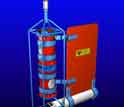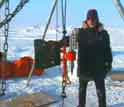Media Advisory 04-21
NSF'S North Pole Researchers Study Climate Change in the Arctic

Among the various tools researchers use are a suite of instruments attached to a mooring cable.
June 17, 2004
This material is available primarily for archival purposes. Telephone numbers or other contact information may be out of date; please see current contact information at media contacts.
Long before a Hollywood blockbuster about catastrophic climate change packed cinema multiplexes this spring, researchers at the top of the world, supported by the National Science Foundation (NSF), were using an array of scientific tools to build a comprehensive scientific picture of environmental change in the Arctic and what it may mean for the rest of the globe.
Led by oceanographer James Morison, of the University of Washington, NSF- supported scientists from Oregon State University, as well as others supported by the National Oceanic and Atmospheric Administration (NOAA), the Naval Post-graduate School, and the Japan Marine Science and Technology Center, are conducting an array of experiments at the North Pole to understand this little-known, but extremely important region.
The Polar regions, scientists believe, will sound the earliest warnings that changes in global climate are underway and, in recent years, the Arctic has experienced a well-documented warming trend. Whether this change is permanent or part of a cycle and what the potential effects of a warmer Arctic Ocean could be are questions the team hopes to answer.
NSF, which funds the North Pole Environmental Observatory (NPEO) through its Office of Polar Programs, is making available video of the researchers working at the Pole, interviews with key NPEO scientists at the Pole and an animation of a mooring string scientists use to place instruments there.
The mooring collects and measures ice thickness and movement, water temperature and salinity, and the speed and direction of underwater polar currents for a year. In keeping with the global scale of the project, the mooring string stretches more than 4.2 kilometers (2.6 miles) from the bottom of the Arctic Ocean to within feet of the constantly shifting polar ice pack. That's longer than Mt. Rainier is high.
In addition to the mooring, scientists with Morison's group are drilling through ice often more than 3.6 meters (12 feet) thick to install NOAA buoys that measure air temperatures through the ice cover.
They also are imbedding automated sensors into the sea ice to send the detectors on a trek thousands of meters long, from the North Pole to Greenland, to measure heat fluctuations in the upper ocean. Subtle changes in these temperatures can mean large variations in the thickness of ice that covers the ocean.
Finally, Morison and colleague Kelly Falkner, of Oregon State University, fly a small aircraft along a line several thousand kilometers long from which they take seawater samples from 1,000 meters below the surface for chemical analysis.
HOW TO RECEIVE C-BAND FEED:
Thursday, June 17, 2:15 – 2:30 p.m. ET IA 6, Tr. 15, DL 4000
** IA 6 Formerly known as Telstar 6**
Technical Info DURING FEED ONLY, NBN, TOC, (212) 684–8910 x 221
VIA PATHFIRE -
On left hand panel of Pathfire, double click on News Broadcast Network, Story # NBN 23365. This story will be available after 4 PM ET on Wednesday, June 16.
FREE FROM NEWS BROADCAST NETWORK, (212) 684- 8910
Hard Copy Information: Shannon Speck, (800) 920 – 6397
Editorial Contact: Peter West, (703) 292 -7761
-NSF-
-
An instrument that measures ocean currents and speed and direction of ice movement.
Credit and Larger Version -
View Video
View streaming video
Credit and Larger Version
Video/Animation Available:
Broadcasters: For B-roll on beta SP, contact Dena Headlee, (703) 292-7739, dheadlee@nsf.gov. A streaming media version of the entire package may be viewed from this page, at bottom right.
Graphics editors:
For a cross-section, at print resolution, of the North Pole mooring camp and an image of a representative instrument used in the observatory, contact Peter West, (703) 292-7761
Media Contacts
Peter West, NSF, (703) 292-8070, email: pwest@nsf.gov
B-Roll Contacts
Dena Headlee, NSF, (703) 292-7739, email: dheadlee@nsf.gov
The U.S. National Science Foundation propels the nation forward by advancing fundamental research in all fields of science and engineering. NSF supports research and people by providing facilities, instruments and funding to support their ingenuity and sustain the U.S. as a global leader in research and innovation. With a fiscal year 2023 budget of $9.5 billion, NSF funds reach all 50 states through grants to nearly 2,000 colleges, universities and institutions. Each year, NSF receives more than 40,000 competitive proposals and makes about 11,000 new awards. Those awards include support for cooperative research with industry, Arctic and Antarctic research and operations, and U.S. participation in international scientific efforts.
Connect with us online
NSF website: nsf.gov
NSF News: nsf.gov/news
For News Media: nsf.gov/news/newsroom
Statistics: nsf.gov/statistics/
Awards database: nsf.gov/awardsearch/
Follow us on social
Twitter: twitter.com/NSF
Facebook: facebook.com/US.NSF
Instagram: instagram.com/nsfgov




